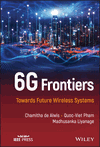Evolution of Mobile Networks
Summary
Mobile networks have been evolving since the 1980s, resulting in a new generation of mobile network every decade. Presently, fifth-generation (5G) mobile networks are being deployed. The sixth-generation (6G) mobile communication networks are expected to mark a disruptive transformation to the mobile networking paradigm by reaching extreme network capabilities to cater to the demands of the future data-driven society. 5G supports enhanced mobile broadband to deliver peak data rates up to 10 Gbps. Network softwarization is a prominent 5G technology that enables dynamicity, programmability, and abstraction of networks. The 6G mobile communication networks, as envisioned today, are expected to provide extreme peak data rates over 1 Tbps. The 6G networks will provide access to powerful edge intelligence that has processing delays falling below 10 ns. Standardization bodies such as the International Telecommunication Union and Third-Generation Partnership Project are expected to develop the specifications to develop 6G by 2026-2027.



